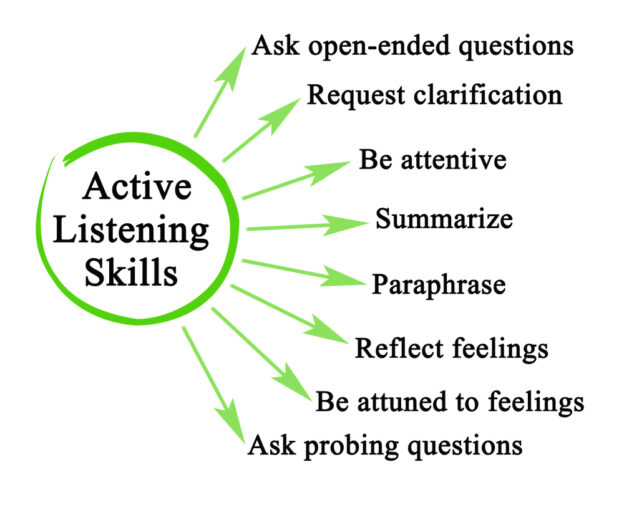This guide outlines the fundamentals of active listening, including paying full attention, showing understanding through feedback, and responding appropriately without judgment. It highlights the importance of empathy, open-mindedness, and engaging fully in conversations to improve communication and build stronger relationships.
Active listening is a critical skill for effective communication, fostering deeper understanding, empathy, and connection between people. Here’s a comprehensive guide to active listening:
1. Pay Full Attention
- Give your undivided attention to the speaker. Avoid multitasking.
- Maintain eye contact without staring, which shows interest and respect.
- Position your body to show you are engaged. Face the speaker, lean slightly forward, and maintain an open posture.
2. Show That You’re Listening
- Use non-verbal cues such as nodding, smiling, and other facial expressions to convey your engagement.
- Offer brief verbal affirmations like “I see,” “Go on,” or “Interesting,” without interrupting the flow of conversation.
3. Provide Feedback
- Reflect on what has been said by paraphrasing. “So, what you’re saying is…”
- Ask clarifying questions to ensure understanding. “What do you mean when you say…?”
- Summarize the speaker’s points to confirm or clarify your understanding. “So, to summarize…”
4. Defer Judgement
- Interrupting is a barrier to active listening. Let the speaker finish each point before asking questions.
- Avoid forming counterarguments while the other person is speaking. Stay open to new perspectives.
5. Respond Appropriately
- Be candid, open, and honest in your response.
- Assert your opinions respectfully. Disagree politely and reason your viewpoints without dismissing the speaker’s.
- Offer solutions or support if appropriate, but don’t jump in with advice unless you’re sure it’s wanted.
6. Keep an Open Mind
- Listen without judging the speaker or mentally criticizing the things they tell you.
- Don’t jump to conclusions; give the speaker a chance to explain their thoughts fully.
7. Practice Empathy
- Try to understand the speaker’s perspective and feelings. Empathizing can help you grasp the message on a deeper level.
- Respond with empathy. Acknowledge the speaker’s feelings with statements like, “It sounds like you’re feeling frustrated,” or, “That must have been difficult for you.”
8. Avoid Interrupting
- Let the speaker express their thoughts without interruption. This shows respect and allows for a clearer understanding of the message.
9. Ask Open-ended Questions
- Encourage the speaker to elaborate or explain further for deeper understanding. “Can you tell me more about…?”
10. Practice, Practice, Practice
- Active listening is a skill that improves with practice. Seek out opportunities to engage in conversations that challenge your listening skills.
Summary
Active listening involves more than just hearing words; it requires a conscious effort to understand, engage, and respond to others thoughtfully and meaningfully. By practising the principles outlined in this guide, you can improve your relationships, foster better understanding, and enhance your overall communication skills.
